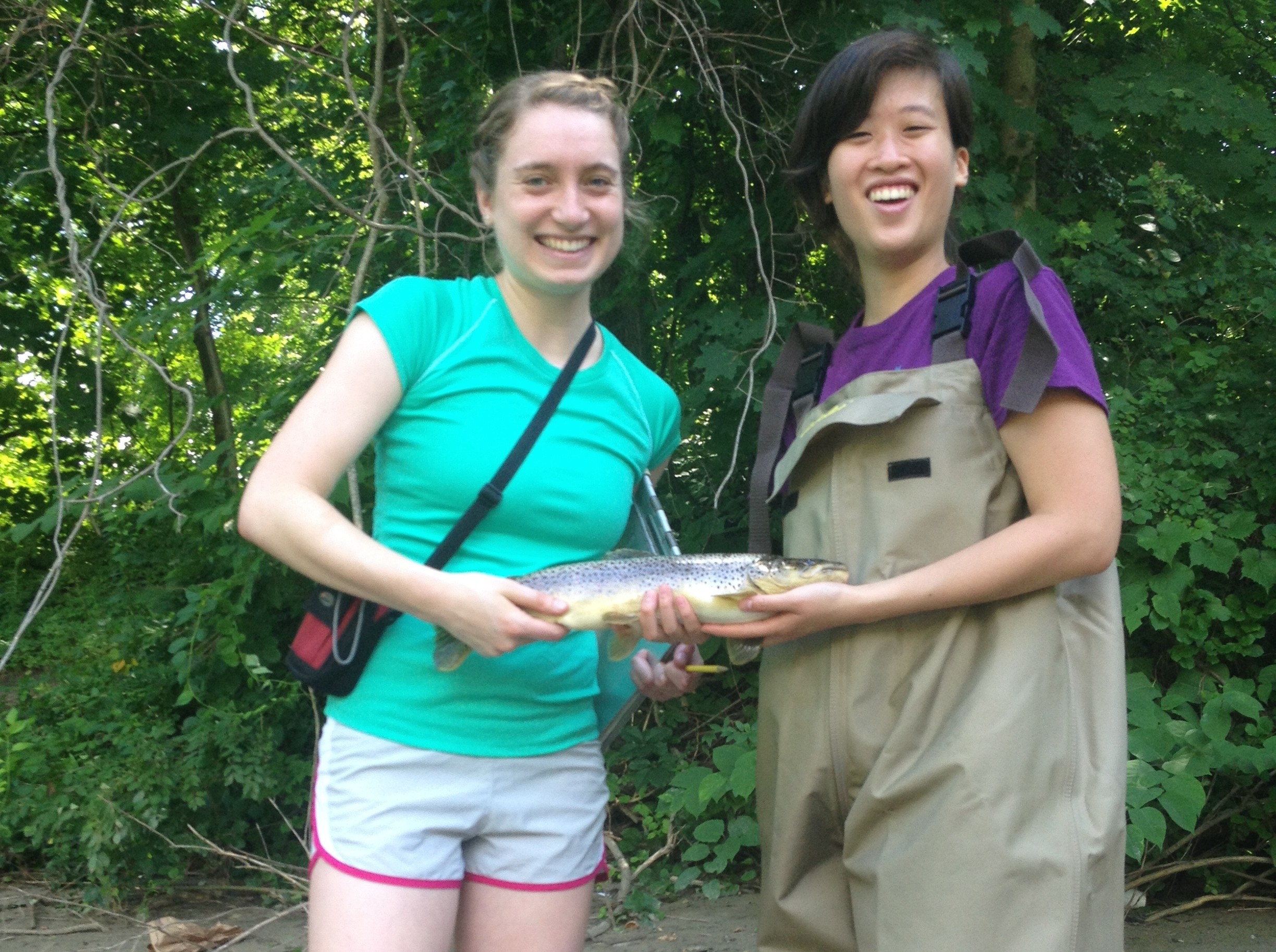By Meagan Goldman ’16
On an early August day this summer, Marissa Shieh and Allie Rowe, two Williams chemistry students, found themselves wading waist-deep through the Hoosic River, scooping trout into a bin. Behind them, a metal boat pushed by scientists from the Massachusetts State Department of Fisheries and Wildlife sent electrical shocks through the water, stunning the fish and facilitating the chase in a process called electrofishing. As the water crept up her waders, Marissa remembered the warning the State Department scientists had given her: not to fall into the river or get water in the waders, otherwise she would be shocked. The waders were barely tall enough, but the students finished the task successfully. At the end of the day, the State Department counted the trout, before releasing most of them back into the river. They gave the remaining fish to Marissa and Allie for their research.
Marissa (’15) and Allie (’16) spent their summer helping Williams chemistry professors David Richardson and John Thoman measure polychlorinated biphenyl (PCB) levels in the Hoosic River. PCB is a carcinogenic chemical that was used industrially in the mid twentieth century due to its highly stable properties. However, the same stable properties that made PCB popular in factories allow it to accumulate and persist in the environment and organisms. Richardson began his research on Hoosic pollution in the early 2000s, measuring PCB levels in river sediments, crayfish, and trout, with the goal of assessing risks for recreational river users.

A chemistry major, Marissa has always been interested in environmental issues. She recalls her childhood fascination with National Geographic articles about global warming and scientific inventions to cope with it. This summer, she explored her interests in both chemistry and the environment. In addition to working in the lab, the students were involved in hands-on jobs like the electrofishing trip, negotiating with the local bureaucracy for permits, and collaborating with fishermen to obtain specimens.
Williams College research on the Hoosic River is part of a larger story. Rising in Western Massachusetts and emptying into the Hudson, the Hoosic is notoriously polluted. It flows past old factory sites like North Adams’ former Sprague Electric Company, which operated through the 1980s and used PCBs in its manufacturing. In 1988, it was discovered that the Sprague Electric Company had disposed of contaminated waste near the river. Subsequent testing revealed high PCB levels near and downstream from the site.
In 2000, a cleanup project attempted to remove PCBs from the area. In the years following the cleanup, Richardson and his team measured PCB levels in hopes of proving the efforts had worked. Their data showed that the PCB levels in sediments were below 2 ppm (parts PCB per million parts soil or tissue), the EPA’s minimum threshold for contamination cleanup, but not significantly lower than levels before cleanup. Richardson also measured PCB levels in crayfish and brown trout. While the contamination in crayfish appeared to have decreased compared to earlier studies, the contamination in trout remained similar and at times exceeded 2 ppm, the cutoff for safe consumption. However, the team only tested a small sample of trout, and their trout data could not be considered conclusive.
This summer, Marissa and Allie had two goals: to clarify data on PCB levels in crayfish by finding standard deviations, and to develop a new research program to allow Richardson and future researchers to focus more on trout. Unfortunately, the machine that measures the PCB concentrations broke partway through the summer, making it difficult for them to finish their research. The data the students did collect indicated that the average concentration of PCBs in Hoosic River crayfish falls within the FDA tolerance range.
The second part of the students’ summer research was establishing a program to facilitate future work on trout. To collect enough fish, they spread the word to local fishermen through The Berkshire Eagle. And, of course, they joined the electrofishing trip. From these experiences, Marissa gained insight into her own interests. She can now see herself pursuing an environmentally-related career, which she believes will be more exciting than lab work – whether or not it involves giant waders and electric boats.
References:
DENNY, E.K., SORRIBAS, A., and RICHARDSON, D.P., 2005, A Snapshot of PCB Levels in the Hoosic River Sediments, Crayfish and Brown Trout in the Tri-State Area: Northeastern Geology & Environmental Sciences, v. 27, no. 4, p. 276-294.
